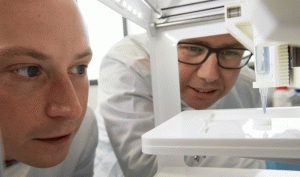UK Researchers Can Rapidly Print Corneas
Latest News
July 13, 2018
UK Researchers Can Rapidly Print Corneas”~“In another major step forward in bioprinting, researchers at Newcastle University have 3D-printd a biocompatible corneal framework that allow the creation of printed corneas.
 Dr Steve Swioklo, co-author with Prof Che Connon (right) as cornea is printed.
Dr Steve Swioklo, co-author with Prof Che Connon (right) as cornea is printed.
Image courtesy of Newcastle University.
According to the research team, there is worldwide shortage of corneas available for transplant. More than 10 million people worldwide typically need surgery to prevent corneal blindness as a result of disease, and almost 5 million suffer total blindness as a result of corneal scarring from burns, lacerations, abrasion or disease.
The new printing process uses gel formulations that can keep corneal stem cells alive, while also holding its shape and still malleable enough to be passed through the print nozzle. Human corneal stromal cells from a donor cornea are mixed with alginate and collagen to create the bio-ink. Multiple corneas can be printed from the cells of a single donor. The corneas can be printed in ten minutes on a low-cost 3D printer.
“This builds upon our previous work in which we kept cells alive for weeks at room temperature within a similar hydrogel. Now we have a ready to use bio-ink containing stem cells allowing users to start printing tissues without having to worry about growing the cells separately,” said researcher Che Connon. He built the technology with Dr. Steve Swioklo.
The initial cornea dimensions were based on an actual cornea, but by scanning a patient’s eye the team could conceivably print a cornea that matched the specific size and shape needed for a particular patient.
“Our 3D printed corneas will now have to undergo further testing and it will be several years before we could be in the position where we are using them for transplants,” Connon said. “However, what we have shown is that it is feasible to print corneas using coordinates taken from a patient eye and that this approach has potential to combat the world-wide shortage.
Source: Newcastle University”
Subscribe to our FREE magazine, FREE email newsletters or both!
Latest News
About the Author
Brian Albright is the editorial director of Digital Engineering. Contact him at [email protected].
Follow DE





